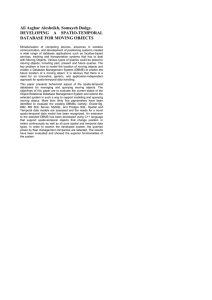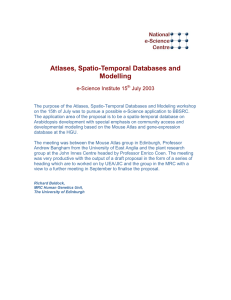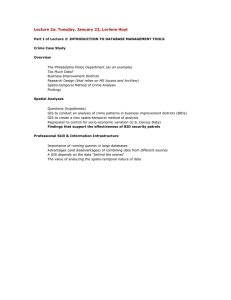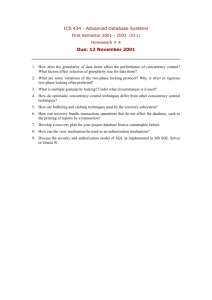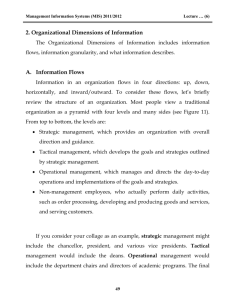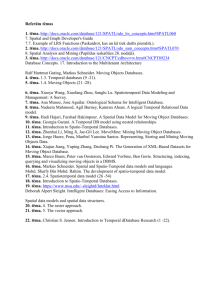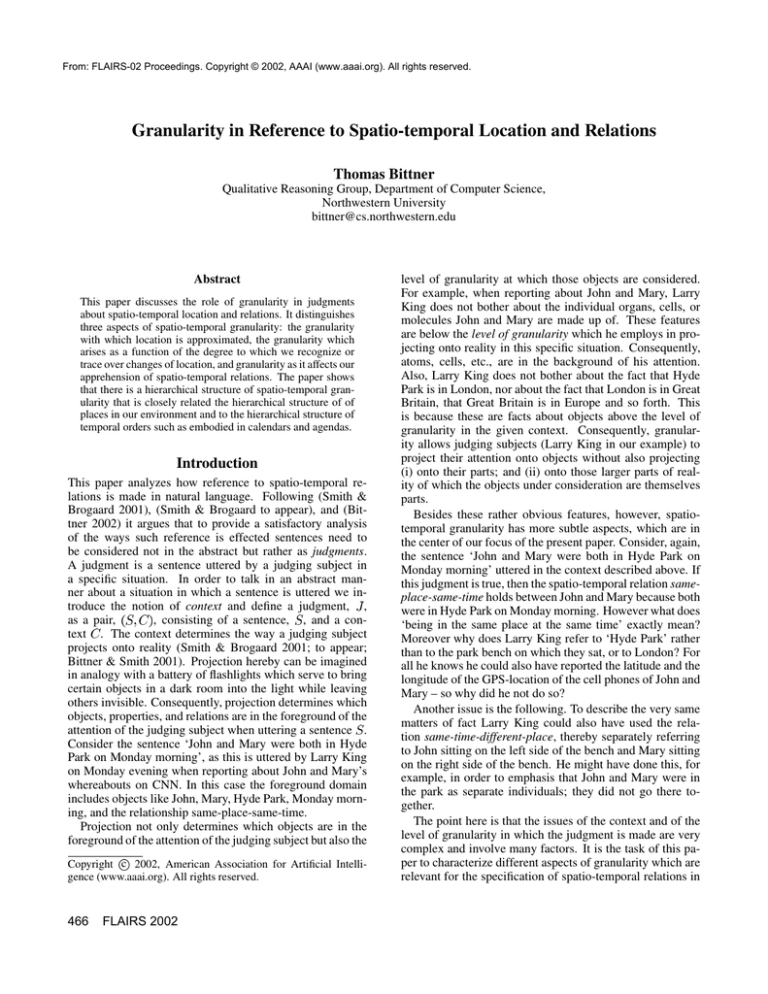
From: FLAIRS-02 Proceedings. Copyright © 2002, AAAI (www.aaai.org). All rights reserved.
Granularity in Reference to Spatio-temporal Location and Relations
Thomas Bittner
Qualitative Reasoning Group, Department of Computer Science,
Northwestern University
bittner@cs.northwestern.edu
Abstract
This paper discusses the role of granularity in judgments
about spatio-temporal location and relations. It distinguishes
three aspects of spatio-temporal granularity: the granularity
with which location is approximated, the granularity which
arises as a function of the degree to which we recognize or
trace over changes of location, and granularity as it affects our
apprehension of spatio-temporal relations. The paper shows
that there is a hierarchical structure of spatio-temporal granularity that is closely related the hierarchical structure of of
places in our environment and to the hierarchical structure of
temporal orders such as embodied in calendars and agendas.
Introduction
This paper analyzes how reference to spatio-temporal relations is made in natural language. Following (Smith &
Brogaard 2001), (Smith & Brogaard to appear), and (Bittner 2002) it argues that to provide a satisfactory analysis
of the ways such reference is effected sentences need to
be considered not in the abstract but rather as judgments.
A judgment is a sentence uttered by a judging subject in
a specific situation. In order to talk in an abstract manner about a situation in which a sentence is uttered we introduce the notion of context and define a judgment, ,
as a pair,
, consisting of a sentence, , and a context . The context determines the way a judging subject
projects onto reality (Smith & Brogaard 2001; to appear;
Bittner & Smith 2001). Projection hereby can be imagined
in analogy with a battery of flashlights which serve to bring
certain objects in a dark room into the light while leaving
others invisible. Consequently, projection determines which
objects, properties, and relations are in the foreground of the
attention of the judging subject when uttering a sentence .
Consider the sentence ‘John and Mary were both in Hyde
Park on Monday morning’, as this is uttered by Larry King
on Monday evening when reporting about John and Mary’s
whereabouts on CNN. In this case the foreground domain
includes objects like John, Mary, Hyde Park, Monday morning, and the relationship same-place-same-time.
Projection not only determines which objects are in the
foreground of the attention of the judging subject but also the
Copyright c 2002, American Association for Artificial Intelligence (www.aaai.org). All rights reserved.
466
FLAIRS 2002
level of granularity at which those objects are considered.
For example, when reporting about John and Mary, Larry
King does not bother about the individual organs, cells, or
molecules John and Mary are made up of. These features
are below the level of granularity which he employs in projecting onto reality in this specific situation. Consequently,
atoms, cells, etc., are in the background of his attention.
Also, Larry King does not bother about the fact that Hyde
Park is in London, nor about the fact that London is in Great
Britain, that Great Britain is in Europe and so forth. This
is because these are facts about objects above the level of
granularity in the given context. Consequently, granularity allows judging subjects (Larry King in our example) to
project their attention onto objects without also projecting
(i) onto their parts; and (ii) onto those larger parts of reality of which the objects under consideration are themselves
parts.
Besides these rather obvious features, however, spatiotemporal granularity has more subtle aspects, which are in
the center of our focus of the present paper. Consider, again,
the sentence ‘John and Mary were both in Hyde Park on
Monday morning’ uttered in the context described above. If
this judgment is true, then the spatio-temporal relation sameplace-same-time holds between John and Mary because both
were in Hyde Park on Monday morning. However what does
‘being in the same place at the same time’ exactly mean?
Moreover why does Larry King refer to ‘Hyde Park’ rather
than to the park bench on which they sat, or to London? For
all he knows he could also have reported the latitude and the
longitude of the GPS-location of the cell phones of John and
Mary – so why did he not do so?
Another issue is the following. To describe the very same
matters of fact Larry King could also have used the relation same-time-different-place, thereby separately referring
to John sitting on the left side of the bench and Mary sitting
on the right side of the bench. He might have done this, for
example, in order to emphasis that John and Mary were in
the park as separate individuals; they did not go there together.
The point here is that the issues of the context and of the
level of granularity in which the judgment is made are very
complex and involve many factors. It is the task of this paper to characterize different aspects of granularity which are
relevant for the specification of spatio-temporal relations in
judgment made by judging subjects.
In general, the notion of granularity is closely related to
the notion of indiscernibility, which refers to the fact that
objects, properties, or relations which are beneath a certain
level of resolution (not necessarily related to size) are indiscernible, i.e., not capable of being distinguished. Following Hobbs (Hobbs 1985) we write
to mean
, where ranges over predicates of some
theory and symbolizes indiscernibility. We make the simplifying assumption that is an equivalence relation.
In this paper we consider indiscernibility of objects regarding their spatio-temporal location (or change therein),
i.e., spatio-temporal granularity and indiscernibility. In particular we consider three aspects or forms of spatio-temporal
indiscernibility corresponding to: (1) the granularity with
which location is approximated; (2) the granularity which
arises as a function of the degree to which we recognize or
trace over changes of location; and (3) granularity as it affects our apprehension of spatio-temporal relations.
A spatio-temporal ontology
In order to provide a formal basis for the discussion of various forms of granularity we start by sketching an ontology of spatio-temporal objects, their locations in space and
time, and relations that hold between spatio-temporal regions based on work published in (Bittner 2002).
Spatio-temporal objects fall into two major categories:
continuants and occurrents (Simons 1987). Continuants are
usually referred to the (atemporal) objects. This is because
they may change over time – for example by gaining or losing parts, by growing older, by changing their location – but
yet remain the same thing. Examples are human beings like
John and Bill Clinton, cars, substances in general. Occurrents do not change over time. They just occur. One usually
refers to them as events or processes rather than as objects.
Examples are ‘John’s flight to New York’, ‘World War 2’,
‘The life of Bill Clinton’, ‘My childhood’, and so on. The
existence of an occurrent always depends on the existence of
one or more continuants. The occurrent ‘John’s childhood’
cannot exist without the continuant John.
We distinguish the domain of spatio-temporal objects, ,
and the domain of regions, . The domain of objects (regions) is the mereological sum of its constituent objects (regions). The domain of regions is constituted by regions of
different dimensionality: four-dimensional spatio-temporal
regions , three-dimensional spatial regions, , and onedimensional temporal regions, . Individual objects stand
to individual regions in the relation of location.
Every (four-dimensional) spatio-temporal object,
( is a part of the domain of objects ), is exactly located
at a single three-dimensional spatial region, , at every instant of time, (Casati & Varzi 1995):
The region
is the exact or precise spatial
location of at the time instant . We say that the object
is located at the region in order to stress the exact fit of
object and region (the object matches the region).
Often, however, it is not very interesting to know that John
is exactly located at that region of space from which the air
is displaced by his body at a particular instant in time. It is
much more interesting to know, for example, that John is in
London or in Paris. We therefore define the notion of apand
proximate location as a family of relations
demand that the object is approximately located in the reif and only if the exact location of is a part
gion ,
and
. The
hereby
of :
represent approximate locations of at at different levels
of granularity, where level of granularity here refers to the
size of the approximating regions.
Most continuants have different exact spatial locations at
different times. We say that these objects change their spatial location. If we consider a temporal region (a period
of time) during which the spatio-temporal object existed,
then may be either (i) at rest, i.e., it may be located in
the same region of space,
over the given period of time
, and write
; or (ii) its spatial location may
change, as a result of being located in different regions of
space at different time-instants during this period. In this
case we consider
to be the mereological sum of all locations visited over the period and write
. An
example for (i) is the location of John on Monday morning
John Monday morning Hyde park ,
in Hyde Park, i.e.,
where Monday morning and Hyde Park specify approximate
location. As an example for (2) imagine that John visits the
Queen on Monday afternoon in Buckingham Palace and that
we we intercept the communication of the Queen’s Secret
Services agents as they trace John’s movement from the entrance through the hall to the guest-room. If we sum up all
those regions, then we get John’s approximate path of movement, i.e.,
John Monday afternoon
, where is the
mereological sum of the rooms John visited in Buckingham
Palace.
Formally we define:
and
(1)
and
(2)
These definitions focus on approximate spatial location but
‘contain’ exact location as special cases. Definitions involving approximate temporal location are omitted here. See
(Bittner 2002) for details.
We represent (four-dimensional) spatio-temporal regions
as pairs of temporal and spatial regions,
. Consider two spatio-temporal regions
and
. We define a set of identity and overlap-sensitive relations based on distinguishing identity (=), proper overlap
which excludes identity but includes containment (o), and
non-overlap (ø) relations among spatial regions and among
temporal regions. This gives raise to nine combinatorial possible spatio-temporal relations (Bittner 2002):
(3)
In order to interpret these formal definitions we need to
can spectake into account that a given pair
ify: (i) the location (the place) at which the continuant is
) or the location (the place) in which
at rest (
FLAIRS 2002
467
the occurrent occurs (
); and (ii) the region
within which the continuant changes location (moves), i.e.,
.
It was shown in (Bittner 2002) that only a subset of the
relations defined in Table 3, the relations 1, 3, 7, 9, are actually referred to in judgments occurring in naturally occurring
contexts. In case (i) these relations are interpreted as: (1) same-place-same-time; (3) - same-time-different-place; (7)
- different-time-same-place; (9) - different-time-differentplace. In case (ii) the relations 1, 3, 7, 9 in Table 3 are
interpreted as: (1) - same-path-same-time; (3) - same-timedifferent-path; (7) - different-time-same-path; (9) - differenttime-different-path. For a details see (Bittner 2002).
Granularity of approximation
The most obvious form of granularity occurs at the level
of approximate specification of location, as in our Larry
King example. Granularity here refers to the size of the region which approximates the exact location of the object in
question. At each time-instant, , there is a single contextand arbitrarily many contextfree exact location relation
dependent approximate localization relations . Approximate location is context-dependent because every context
comes with its own family of approximate location relations,
. Consequently, we assume that each context is characterized (1) by a specific period of time over which it is active;
and (2) by a corresponding family of approximate location
relations which uniquely covers all instances in .
The corresponding indiscernibility relation between objects and regarding their spatial location in the context characterized by and are is defined as:
where
expands to in
and
, which indicates that at
this level we do not consider whether the object is at rest at
over or whether it moves/changes within
over .
Examples are for reference to objects indiscernible regarding their spatio-temporal location are: ‘the people in
this building’, ‘the participants of this year’s New York
Marathon’, ‘the passengers of Flight 847’, etc.
Recognizing or ignoring change
We argue that one can distinguish two major categories
of occurrents: events and processes. Events are spatiotemporal objects whose existence depends on the occurrence
of a certain continuant in a certain state, e.g., the occurrent ‘John’s childhood’ corresponds to the continuant John
persisting in the state of being a child. Processes, on the
other hand, depend to the occurrence of change undergone
by some continuant. For example, the process of ‘John’s
growing up’ corresponds to certain patterns of changes of
the continuant John. We now shall argue that the matter of
fact whether a continuant is in a certain state which does not
change over a period of time or whether it undergoes a certain change during this period is a matter of granularity. It
follows, therefore, that the distinction between events and
processes is a matter of granularity too.
468
FLAIRS 2002
Consider the continuant John, who is flying aboard Flight
847 from London to New York. There are (at least) two colocated occurrents: the event of John’s flight to New York
and the process of John’s flying to Now York. The event of
John’s flight depends on the continuant of John who is in
the state of being an adult, healthy human individual who
undertakes air-travel from London to New York. This state
does not change while the event lasts. The process of John’s
flying, on the other hand depends of the change of location
John’s body undergoes while moving from London to New
York. This change occurs as long as the process lasts.
The two occurrents (event and process) depend on the
same continuant, John. Both exist over the same period of
time. However the level of granularity under which a judging subject projects onto reality (the continuant John) when
she is referring to the event of John’s flight is distinct from
the level of granularity under which she projects onto reality
when she is referring to the process of John’s flying.
When referring to the event John’s flight the judging subject projects onto reality at a level of granularity that ‘traces
over’ the fact that John’s body is actually moving in a certain way. Under the level of granularity with which she
projects onto reality the continuant John is in the state described above. For example, John’s biographer could write
a sentence like: ‘This flight to New York marked the begin
of a new chapter in John’s live’.
When referring to the process of ‘John’s flying’ then the
judging subject projects onto reality at a level of granularity
that focuses onto the fact that John’s body is actually moving
in a certain way. Referring to an occurrent as a process implies a finer level of granularity, one that does not trace over
the properties of the change that occurs. For example, John’s
biographer could continue by writing ‘The turbulences were
so strong that people who had not fastened their seat belts
were flying through the cabin’.
Consequently, if the occurrent to which the judging subject refers to is a process then she projects onto reality at
a level of granularity that focuses on the properties of the
changes that occur. This is because the process depends on
the occurrence of these changes. If the judging subject refers
to an event then she projects onto reality at a level of granularity that traces over the changes that occur. This is because
the events depends on one or more continuants that are in a
certain state.
We now can refine the indiscernibility relation between
objects as regards the identification of their spatio-temporal
location by taking into account whether the region
is: (i)
a location at which the object is at rest; (ii) a region which is
identical to the sum of locations visited over a period of time.
More precisely in case (i) any change of location is below the
level of granularity. In case (ii) objects are indiscernible only
if they change in such a way that they visit the locations they
visited within sum up to the same region . Formally we
write:
(i)
(ii)
Examples are (i) ‘The people in this building’, (ii) ‘The participants of this year’s New York Marathon’. Notice, how-
ever that in the second case we cannot distinguish the athlete
jogging from start to finish from the drunk ‘athlete’ who gets
mixed up with the race but takes the opposite direction.
Consequently, the different interpretation of the spatiotemporal relations (1,3,7,9) in Table 3 as relations between
paths (e.g., 1 interpreted as same-path-same-time) and as
relations between places (e.g., 1 interpreted as same-placesame-time) is a matter of spatio-temporal granularity. The
different interpretations arise according to whether: (a)
Judging subjects use the notion of place in order to refer
to locations (spatial regions) in which objects are at rest.
A judging subject considers a spatio-temporal object as being at rest if it does not change its approximation location
according to level of granularity at hand. (b) Judging subjects use the notion of path in order to refer to certain spatial regions along certain kinds of change of location occurs
(movement).
Granularity of sets of relations
In Table 3 we defined relations between spatio-temporal regions by considering the relations , , and among the
relevant spatial and the temporal components of such regions. Since the nine relations we distinguished are jointly
exhaustive and pair-wise disjoint they subdivide the domain
of spatio-temporal regions into equivalence classes, i.e., they
impose a granularity. Formally we define:
The indiscernibility relation thus defined applies
to regions rather than to objects. Since we assume absolute
space and time (regions do not change but objects do) the
granularity imposed by is context independent.
The theory underlying the definitions in Table 3 is a fragment of mereology. Moreover they do not take the ordering
underlying the temporal domain into account. As shown in
(Bittner to appear) and (Bittner 2002) the relations in Table 3
can be refined by taking full mereology as well as by taking
ordering relations into account. Consider, for example, the
relation (7) in Table 3 in the interpretation of same-placedifferent-time. Taking the direction of the time-line into
account same-place-same-time refines to same-place-before
and same-place-after.
Refining the sets of spatio-temporal relations results into
a finer granularity of the subdivision in the domain of pairs
of objects. From the structure of the definitions of the relations provided in (Bittner to appear) it follows that the corresponding granularities are ordered hierarchically in such a
way that multiple relations on a finer level of granularity are
subsumed by a single relation on a coarser level.
Relations between spatio-temporal regions are context
independent which means that for every pair of spatiotemporal regions there are relations that hold no matter what
the context. However those relations are structured hierarchically and the judging subject has the freedom to choose
the level of granularity which she considers to be most appropriate in order to make a judgment in a determinate and
efficient manner. For example, overlap and identity sensitive relations like same-place-same-time and same-placedifferent-time are often used when a subject makes a judgment about causal relationships between spatio-temporal ob-
jects that require the objects to be in the same place at the
same time. In those contexts finer distinctions at the level
of relations (like same-place-before or same-place-after) are
often irrelevant and therefore omitted by choosing a coarse
level of granularity. On the other hand, when reporting the
spatio-temporal locations of cars that were involved in a traffic accident to the jury in a curt of law the investigating officer will judge about spatio-temporal relations at the finest
available level of granularity.
Ordering structure
We use the notation
in order to refer to the set of equivalence classes, i.e., the granularity, generated or imposed by
. Different forms of granularity create different subdivisions of spatio-temporal objects and relations in into equivalence classes. We now define a partial ordering between the
granularities and with indiscernibility relations
and
:
This ordering forms a partial order with the domain itself as
unique maximal element. There is a finest level of granularity if there are atoms.
As discussed above sets of jointly exhaustive and pairwise disjoint spatio-temporal relations create hierarchically
ordered granularities. It is important to remember that these
granularities subdivide the domain of spatio-temporal regions (and are therefore context free). In order to link the
granularity of pairs of regions to objects we need the notion
of location, which is itself subject to granularity.
Given a fixed collection of objects, , (atoms or not)
and their spatial location at a certain time-instant the finest
spatio-temporal granularity we can achieve is by considering the exact location of those objects. Notice, however
that even in this case we cannot distinguish objects that are
spatio-temporally exactly co-located. Let
be the granularity imposed on by the indiscernibility of exactly spatiobe the granularity
temporally co-located objects and let
on created by considering approximate location at the inis then of finer granularity
stant determined by .
than
since objects indiscernible in
are also indis, i.e.,
cernible in
Consider now the spatial location of the objects in
over the interval . Since objects in potentially change
their location we consider the spatio-temporal location
and assume that
is the mereological sum
of the regions at which was located exactly at some in(the limit case in Equation 2)). This results in
stant in
. If we consider exact spatial location
the granularity
over time intervals rather than at time instants then we
gain a finer granularity, since now we can also distinguish
objects that are only temporarily exactly co-located. Since
we assume that
is the mereological sum of the regions at
which was located exactly at some instant in , we can
distinguish objects whose change of location does not sum
up to the same region (motion-path) . Consequently, we
with
.
have
FLAIRS 2002
469
Of course, there are multiple ways of imposing a granularity on a collection of objects by considering their approximate location. Given two of those granularities they may or
may not be refinements of each other. In order to determine
an ordering structure here we need to consider how granularity is imposed in specific judgments. Here the judging
subject actively reaches out and in principle can choose arbitrary regions that satisfy definitions 1 and 2. If, however, we
analyze language expressions that specify the approximate
spatial location of some given object, then we see that the approximate location is specified with respect to some place,
such as ‘Hyde Park’, ‘Soho’, ‘The theater district’, ‘London’, etc. Those places have the following properties: (a)
they are well known and (b) they do themselves not change.
Place with those properties serve as objects of reference for
the description of approximate spatial location.
The situation is similar for approximate temporal location. In our example the approximate temporal location is
given with respect to a calendar unit such as Monday morning. Calendar units such as minutes, hours, days, weeks,
etc. partition the time line into jointly exhaustive and pairwise disjoint temporal regions at different levels of granularity and provide frames of reference. Again, an important
aspects of the temporal frames of reference are that they are
well known and do themselves not change. For details see
(Bittner to appear).
It follows from the above that: (a) the hierarchical structure of spatial granularities of approximate specifications
of spatio-temporal location coincides with the hierarchical
structure of places in our environments; (b) the hierarchical structure temporal granularities of approximate specifications of spatio-temporal location coincides with the hierarchical structure embodied in our calendars; and (c) the
hierarchical structure of spatio-temporal granularity is the
cross-product of the hierarchical structures of the spatial and
temporal components involved.
When making a judgment about spatio-temporal relations
judging subjects traverse those ordering structures in order
to find an appropriate level of granularity for specifying approximate location. Larry King chose ‘Hyde Park’ in order
to specify the approximate spatial location of John and Mary
and ‘Monday morning’ in order to specify their approximate
temporal location. The choice of these levels of granularity
allowed him to specify the relation same-place-same-time in
order to describe the spatio-temporal relation between John
and Mary. ‘Hyde Park’ is the most specific place he can expect his audience to know. Not many people in the United
States are likely to know the placement of every bench in
Hyde Park. Therefore referring to a specific bench would
result in a true but useless judgment since it does not convey
the intended information to the intended audience.
Conclusions
In this paper we analyzed three aspects of spatio-temporal
granularity: (i) the granularity of our specifications of approximate location; (ii) the ways we recognize or trace
over changes of location; (iii) granularity of spatio-temporal
relations. Aspects (i) and (ii) determine the relationships between spatio-temporal objects and corresponding re-
470
FLAIRS 2002
gions of space and time and involve the factor of contextdependence. Aspect (iii) relates to the hierarchical organization of spatio-temporal relations and so does not involve
this factor.
The most important aspect of spatio-temporal granularity is the granularity in which approximate spatio-temporal
location is specified. The hierarchical structure of spatiotemporal granularity is a function of the hierarchical structures of the underlying spatial and temporal components.
The nature of temporal granularities is relatively well understood (Bettini et al. 1998). In order to gain a better understanding of levels of granularity in spatial approximations it
is important to gain a better understanding of the way places
and hierarchies of places are formed. A promising approach
towards an understanding of this subject seems to be the
theory of granular partitions proposed in (Bittner & Smith
2001).
Acknowledgements
Thanks are due to Barry Smith for his helpful comments.
The support by DARPA under the Rapid Knowledge Formation program and the National Science Foundation under
the Research on Learning and Education program is gratefully acknowledged.
References
Bettini, C.; Dyreson, C.; Evans, W.; Snodgrass, R.; and
Wang, X. 1998. A glossary of time granularity concepts.
In O. Etzion, S. Jajodia, S. S., ed., Temporal Databases:
Research and Practice, number 1399 in LNCS State-ofthe-art Survey, 406–413.
Bittner, T., and Smith, B. 2001. A taxonomy of granular partitions. In D.R.Montello., ed., Spatial Information
Theory, COSIT ’01, volume 2205 of Lecture Notes in Computer Science, 28–43. Berlin/New York: Springer.
Bittner, T. 2002. Judgments and spatio-temporal relations. In Proceedings of the Eighth International Conference on Principles of Knowledge Representation and Reasoning (KR2002). Morgan Kaufmann.
Bittner, T. to appear. Approximate qualitative temporal reasoning. Annals of Mathematics and Artificial Intelligence.
Casati, R., and Varzi, A. 1995. The structure of spatial
localization. Philosophical Studies 82(2):205–239.
Hobbs, J. 1985. Granularity. In Proceedings of the IJCAI
85, 432–435.
Simons, P. 1987. Parts, A Study in Ontology. Oxford:
Clarendon Press.
Smith, B., and Brogaard, B. 2001. A unified theory of truth
and reference. Logique et Analyse.
Smith, B., and Brogaard, B. to appear. Quantum
mereotopology. Annals of Mathematics and Artificial Intelligence.

